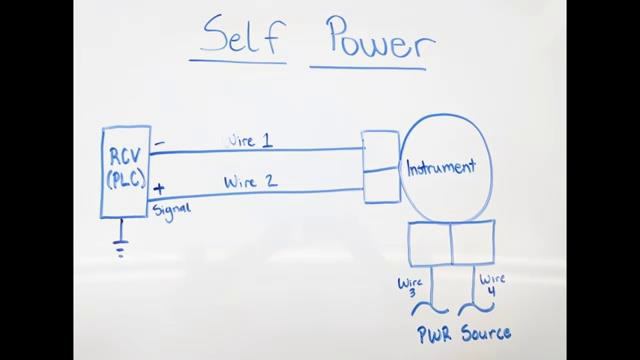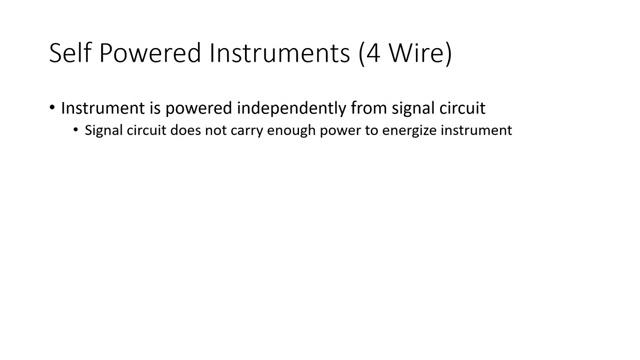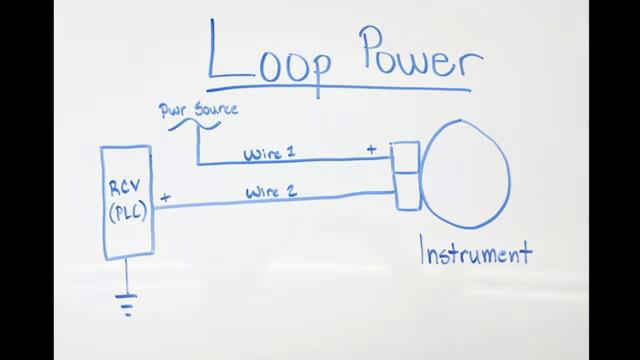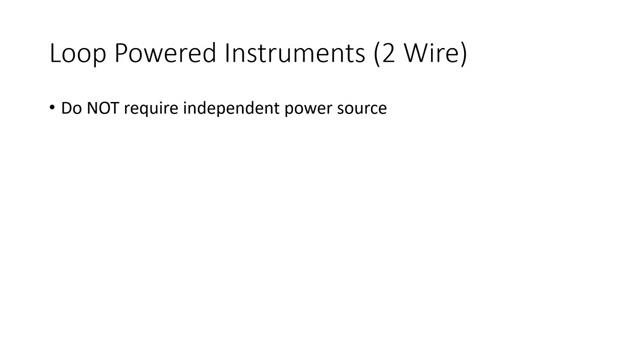Loop_vs__Self_Powered_Control_Instrumentation.pdf
Self Powered Instruments (4 Wire)
- Instrument is powered independently from signal circuit
- Signal circuit does not carry enough power to energize instrument
- If wired as a loop powered instrument, it will not function properly
- Very common
- Many different instruments use this type of wiring configuration
- Allows for more complex functionality because of the added power
Loop Powered Instruments (2 Wire)
- Do NOT require independent power source
- The power being provided comes from the signal circuit
- Lower amounts of power
- Limited instrument functionality because of low amounts of power
- More simplistic, easier to wire
- Offer a lot of flexibility because of ability to install instruments without another power source
Transcript
[0m:4s] Hi I'm Josh Bloom, welcome to another video in the RSP Supply education series. If you find that these videos are helpful to you, it certainly helps us out if you could give us a big thumbs up and subscribe to our channel.
[0m:15s] In today's video, we are going to be talking about industrial control. More specifically, we want to talk about some of the instruments that are commonly used in different industrial applications and how those instruments are powered. There are two very common methods you see many of these industrial instruments using today.
[0m:35s] One method of providing power is called loop, power or sometimes called 2 wire.
[0m:41s] And the other method is called self-power, sometimes referred to as 3 or 4 wire.
[0m:47s] In this video, we will discuss the main differences between these two wiring methods and discuss some of the pros and cons of each to hopefully provide you with a better understanding of how this industrial wiring is commonly handled, and also, what method might be better for your specific application.
[1m:8s] In almost all cases measurement instruments in industrial commercial and even residential applications need power.
[1m:16s] These instruments can be anything from a flow meter, to a pressure transducer, amp meter, as well as many others.
[1m:24s] How these instruments are powered can vary depending on a few different factors.
[1m:29s] In many cases, the instrument itself can only operate with a certain kind of power configuration, while other instruments give you multiple options.
[1m:40s] In almost all cases, the instrument will need to be either loop powered or self powered.
[1m:46s] So what is the difference between these two methods?
[1m:49s] Let's start with self-powered or 4 wire instruments.
[1m:54s] The main thing to know in this type of application is that the instrument will need to be powered independently from the device reading or sending the signal.
[2m:5s] For example, if a flow meter uses a 4 to 20 milliamp signal to transmit back to the PLC, the current loop or process loop for this instrument is used only to send and receive

[2m:22s] It does not carry the power needed to energize the meter itself.

[2m:28s] So if you only terminate the current loop or signal loop to this kind of instrument, it will not work. The flow meter needs independent power for it to operate properly. So, with this example, the flow meter might require 120 volts AC independent from the process loop to function properly, which can then allow it to record and send the 4 to 20 milliamp signal back to the PLC or whatever device is reading the data. So again, in a self-powered or 4 wire set up the instrument will require independent power, not power from the process loop in order to send and receive data.
[3m:10s] So now let's look at instruments that use loop power or also referred to as 2 wire.
[3m:17s] The main difference that distinguishes loop powered instruments from self-powered instruments is that these types of instruments do not require independent power.
[3m:28s] Let's look at another example.
[3m:31s] Let's assume we have a pressure transducer that is submerged in some kind of liquid.

[3m:36s] In this scenario, while not impossible, it would be difficult to provide independent power for this device that is fully submerged in a liquid.
[3m:46s] So it makes sense to be able to provide power in another way, or in this case, loop power. In these types of instruments, the power is sent to the device through the process loop or signal loop.

[3m:59s] The same conductors that also provide us the 4 to 20 milliamp signal that we get the data from.
[4m:6s] These devices also tend to be more limited in the features that they can provide because of the minimal amount of power which they can draw upon. However, they can provide great flexibility and many different applications because of the simplistic nature and low number of conductors that need to be used.
[4m:25s] Determining which method is best is not always the right approach. Instead, it is important to determine what the instrument or device is capable of, and in what application you plan to use the instrument that will dictate if you need to use power provided by loop or self-power.
[4m:43s] For a full line of industrial hardware and thousands of other products, please go to our website. For more information or other educational videos, go to RSPSupply.com, the Internet's top source for industrial hardware. Also, don't forget: like and subscribe.




